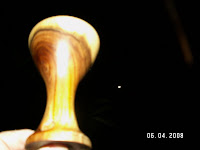

all the best,
The ramblings of a bloke whose mid-life crisis has taken the form, not of little red sports cars and buxom blondes, but of trying to make musical instruments, particularly those of another era. For a man without a musical bone in his body, this may seem strange. C'est la vie.


 and have had the intention to "do something" with it for a long, long time.
and have had the intention to "do something" with it for a long, long time.
And it's better than it has any right to!
It started in The Guru's workshop, when I said I thought I'd turn the blank upside down and try a natural edge bowl. ( You HAVE noticed the edge isn't nice and flat and even, it's all wavey!)
The Guru said "Hmmmm. Whatever you reckon".
You need to know him to understand what that revealed of his opinion of the idea.
But I went ahead, and received the usual guidance and assistance. And all went fairly well.
At the sanding stage I took it home, intending to finish it on my newly acquired Jet mini-lathe. But I found I couldn't mount it, as the spigot on the bowl was to big for my only chuck.
Dammit!
I shelved tlhe bowl (literally) for a while, then had a brilliant idea. I drilled the base of the bowl and turned and fitted a pedestal. Wundebar. You are bnrighter than Einstein even...
Unfortunately, the pedestal wasn't quite exactly straight, or centred, or perhaps both. And when you put a slightly off balance lump on a lathe, the unbalance is magnified.
I shelved it again!!
Then, a few days ago, I plucked up my courage, gritted my teeth, put my shoulder to the wheel, my nose to the grindstone... and found it was impossible to work in that position.
So I attached the bowl to the lathe via the pedestal, and spent an uncomfortable hour or so sanding and polishing with the bowl thumping and bumping in unbalance.
And the result is OK. Not perfect - [perfection is for the gods).
But OK is OK.
Natural edge bowl on pedestal, New Guinea rosewood, finish Rustins Plastic.
all the best
vsquared47

 This is the completion of a small order for pens, which will now travel to the far side of the world, before meeting their users.
This is the completion of a small order for pens, which will now travel to the far side of the world, before meeting their users.
 The heading is a bit misleading. Only two of the items illustrated are hairy oak: the two reddish-brown pens.
The heading is a bit misleading. Only two of the items illustrated are hairy oak: the two reddish-brown pens.


 I was about to buy a new lathe, when a used lathe of the same type was offered, including an extension bed, stand, an armful of chisels and gouges, a chuck, and some other goodies.
I was about to buy a new lathe, when a used lathe of the same type was offered, including an extension bed, stand, an armful of chisels and gouges, a chuck, and some other goodies.
 A camphor laurel bowl. I hope Pat enjoys it.
A camphor laurel bowl. I hope Pat enjoys it.



 Small bowl - Raintree.
Small bowl - Raintree. A small clock, inset into Raintree. Thanks t
A small clock, inset into Raintree. Thanks t o Tom for the photo.
o Tom for the photo. Vase - Raintree timber.
Vase - Raintree timber. 